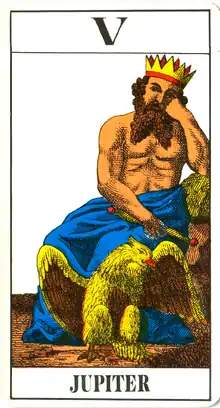
The Swiss Tarot deck is a 78-card deck used for the tarot card games Troccas and Troggu. It is also sometimes called the JJ Tarot or 1JJ Tarot due to the presence of the cards representing Juno and Jupiter.[lower-alpha 1]
History
The deck is derived from the Tarot de Besançon, which itself comes from the Tarot of Marseilles.[1][2] It is an Italian suited pack which substitutes the figures of Juno and Jupiter in place of the Popess and Pope of the Tarot of Marseilles. The first version was produced between 1831 and 1838 in the card factory of Johann Georg Rauch. It was the first tarot pack made by the factory and was unexpectedly successful in the American market. The first version was manufactured, unaltered, by his successor, Johannes Müller in Diessenhofen until 1860.[3]
In 1965 the Swiss card game firm, A.G. Müller, issued a reprint which is distinguished by its cleaner lines. The alternative name for the pack comes from this edition, the "1" simply being a number within the product line and "JJ" the replacement of 2 trumps by Juno and Jupiter (see below).
Cards
The face cards are not double headed and both the trumps and pip cards use additive Roman numeral indexing. The lack of modern features like vertically symmetrical face cards, corner indices, and Arabic numerals has made this deck unpopular for tarot players outside of their native communities. For example, the French-speaking Swiss (Romands) prefer using the Tarot Nouveau to play French tarot. It is still the official deck for Troccas tournaments.
Troccas players use the French-language version but refer to their cards with their Romansh (Rhæto-Romanic) nicknames.[4] Troggu players use the German version. The names of the trump cards are as follows:
| Number | Caption | Rhæto-Romanic | |||
|---|---|---|---|---|---|
| French | German | English | Name(s) | Translation | |
| O | Le Mat | Der Narr | The Fool | il matto | The Fool |
| I | Le Bateleur | Der Magier | The Magician | il bagat | the shell game player |
| II | Junon |
|
| ||
| III | L'Impératrice | Die Herrscherin | The Empress | l'imperatura | the empress |
| IIII | L'Empéreur | Der Herrscher | The Emperor | igl imperatur | the emperor |
| V | Jupiter |
|
| ||
| VI | L'Amoureux | Die Liebenden | The Lovers | ils inamurai | the lovers |
| VII | Le Chariot | Der Wagen | The Chariot |
|
|
| VIII | La Justice | Gerechtigkeit | Justice |
|
|
| VIIII | L'Ermite | Der Eremit | The Hermit | il pader | the monk |
| X | La Roue de Fortune | Rad des Schicksals | Wheel of Fortune |
|
|
| XI | La Force | Kraft | Strength | la forza | strength |
| XII | Le Pendu | Der Gehängte | The Hanged Man | il pendiu | the hanged man |
| XIII | La Mort | Der Tod | Death | la mort | death |
| XIIII | Tempérance | Die Mässigkeit | Temperance |
|
|
| XV | Le Diable | Der Teufel | The Devil |
|
|
| XVI | La Maison de Dieu | Der Turm | The Tower |
|
|
| XVII | L'Étoile | Der Stern | The Star | las steilas | the stars |
| XVIII | La Lune | Der Mond | The Moon | la glina | the moon |
| XVIIII | Le Soleil | Die Sonne | The Sun | il sulegl | the sun |
| XX | Le Jugement | Gericht | Judgment |
|
|
| XXI | Le Monde | Die Welt | The World |
|
|
Footnotes
- ↑ "Swiss Tarot" is the name recommended by the International Playing-Card Society.[1]
References
- 1 2 Swiss Tarot at i-p-c-s.org. Retrieved 24 October 2023.
- ↑ Mann, Sylvia (1990). All Cards on the Table. Leinfelden: Deutsches Spielkarten-Museum. pp. 166–168, 172.
- ↑ Ruh, Max (2005) Schaffhauser Spielkarten. Schweizer Pioniere der Wirtschaft und Technik. Verein für wirtschaftshistorische Studien, Zurich 2005, ISBN 3-909059-32-5, pp 27–31, 52 and 73.
- ↑ McLeod, John. Troccas at pagat.com. Retrieved 13 February 2018.
External links
 Media related to Tarot 1JJ at Wikimedia Commons
Media related to Tarot 1JJ at Wikimedia Commons
